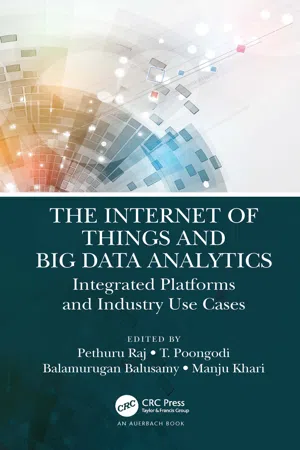
The Internet of Things and Big Data Analytics
Integrated Platforms and Industry Use Cases
- 324 pages
- English
- ePUB (mobile friendly)
- Available on iOS & Android
The Internet of Things and Big Data Analytics
Integrated Platforms and Industry Use Cases
About this book
This book comprehensively conveys the theoretical and practical aspects of IoT and big data analytics with the solid contributions from practitioners as well as academicians. This book examines and expounds the unique capabilities of the big data analytics platforms in capturing, cleansing and crunching IoT device/sensor data in order to extricate actionable insights. A number of experimental case studies and real-world scenarios are incorporated in this book in order to instigate our book readers. This book
- Analyzes current research and development in the domains of IoT and big data analytics
- Gives an overview of latest trends and transitions happening in the IoT data analytics space
- Illustrates the various platforms, processes, patterns, and practices for simplifying and streamlining IoT data analytics
The Internet of Things and Big Data Analytics: Integrated Platforms and Industry Use Cases examines and accentuates how the multiple challenges at the cusp of IoT and big data can be fully met. The device ecosystem is growing steadily. It is forecast that there will be billions of connected devices in the years to come. When these IoT devices, resource-constrained as well as resource-intensive, interact with one another locally and remotely, the amount of multi-structured data generated, collected, and stored is bound to grow exponentially. Another prominent trend is the integration of IoT devices with cloud-based applications, services, infrastructures, middleware solutions, and databases. This book examines the pioneering technologies and tools emerging and evolving in order to collect, pre-process, store, process and analyze data heaps in order to disentangle actionable insights.
Frequently asked questions
- Essential is ideal for learners and professionals who enjoy exploring a wide range of subjects. Access the Essential Library with 800,000+ trusted titles and best-sellers across business, personal growth, and the humanities. Includes unlimited reading time and Standard Read Aloud voice.
- Complete: Perfect for advanced learners and researchers needing full, unrestricted access. Unlock 1.4M+ books across hundreds of subjects, including academic and specialized titles. The Complete Plan also includes advanced features like Premium Read Aloud and Research Assistant.
Please note we cannot support devices running on iOS 13 and Android 7 or earlier. Learn more about using the app.
Information
Chapter 1
Taxonomy of Big Data and Analytics Solutions for Internet of Things
1.1 Introduction
1.1.1 IoT Emergence
1.1.2 IoT Architecture
Table of contents
- Cover
- Half Title
- Title Page
- Copyright Page
- Table of Contents
- Preface
- Author Biography
- Contributors
- 1 Taxonomy of Big Data and Analytics Solutions for Internet of Things
- 2 Big Data Preparation and Exploration
- 3 Emerging IoT-Big Data Platform Oriented Technologies
- 4 IoT-Big Data Systems (IoTBDSs) Enabling Technologies: Ubiquitous Wireless Communication, Real-Time Analytics, Machine Learning, Deep Learning, Commodity Sensors
- 5 Distinctive Attributes of Big Data Platform and Big Data Analytics Software for IoT
- 6 Big Data Architecture for IoT
- 7 Algorithms for Big Data Delivery over Internet of Things
- 8 Big Data Storage Systems for IoT – Perspectives and Challenges
- 9 Key Technologies Enabling Big Data Analytics for IoT
- 10 Internet of Things (IoT) and Big Data: Data Management, Analytics, Visualization and Decision Making
- 11 Big Data Programming Models for IoT Data
- 12 IoTBDs Applications: Smart Transportation, Smart Healthcare, Smart Grid, Smart Inventory System, Smart Cities, Smart Manufacturing, Smart Retail, Smart Agriculture, Etc.
- 13 Big Data Management Solutions for IoT: Case Study – Connected Car
- Index